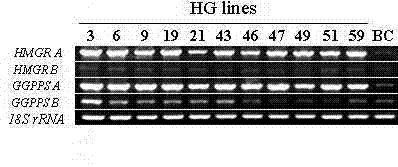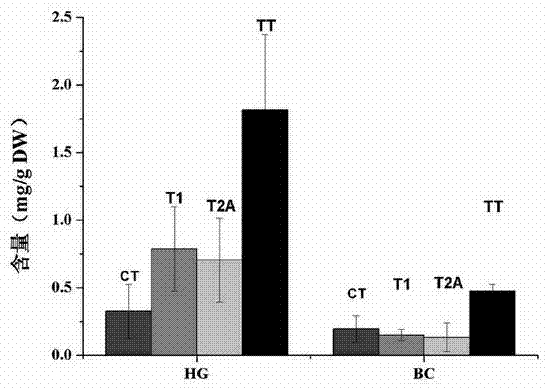Method for increasing tanshinone content of salvia miltiorrhiza hairy roots by transferring SmGGPPS gene
A technology of tanshinone content and hairy root, applied in the field of genetic engineering, can solve problems such as poor stability, complex tanshinone structure, and reduced content of active ingredients, and achieve reliable effects, increase total tanshinone content, and low cost
- Summary
- Abstract
- Description
- Claims
- Application Information
AI Technical Summary
Problems solved by technology
Method used
Image
Examples
Embodiment 1
[0072] (1) Extraction of total RNA from Salvia miltiorrhiza and synthesis of the first strand of cDNA:
[0073] Using the RNA prep pure plant kit provided by TIANGEN, follow the steps specified in the instructions in the kit to extract total RNA from the transgenic hairy roots of Salvia miltiorrhiza. The fresh weight of the transgenic hairy roots of Salvia miltiorrhiza used to extract total RNA is 0.1g, and the DNA in the sample during the extraction process is removed with DNase working solution. Measure the absorbance of the extracted RNA on a spectrophotometer to calculate the purity and concentration of the extracted RNA. After calculating the concentration of different RNA samples, 0.5μg RNA was used as the initial amount to synthesize the first-strand cDNA with reverse transcriptase XL (AMV), and the operation steps were in accordance with the instructions provided by Promega.
[0074] (2) SmGGPPS Design of coding sequence-specific primers and obtain target gene fragments:
...
Embodiment 2
[0077] With SmGGPPS Construction of plant expression vector of gene.
[0078] (1) Intermediate vector pCAMBIAl304 + The build:
[0079] Use pBIl21 and pCAMBIAl304 as materials to construct plant expression vector pCAMBIAl304 + . Specifically, HindIII / EcoRI double enzyme digestion of pBI121 and pCAMBIAl304; recovery of the pBI121-GUS expression cassette and pCAMBIAl304 large fragment; ligation transformation, picking of monoclonal colonies to extract plasmids for verification. The results showed that the plant expression vector pCAMBIAl304 + The build was successful.
[0080] (2) Plant expression vector pCAMBIAl304 + - SmGGPPS The build:
[0081] PCAMBIAl304 successfully constructed in the above + Based on the use of cloned from Salvia SmGGPPS Gene replacement above GUS gene. The specific method is BamHI / SacI double enzyme digestion pMD18T- SmGGPPS And pCAMBIAl304 + ; Recycling SmGGPPS Gene and pCAMBIAl304 + Large fragments; ligation transformation, picking of monoclonal colonies f...
Embodiment 3
[0084] Agrobacterium rhizogenes mediated SmGGPPS Genetically transformed Salvia miltiorrhiza to obtain transgenic hairy roots.
[0085] (1) Containing plant expression vector pCAMBIAl304 + - SmGGPPS Obtaining of Agrobacterium rhizogenes engineering bacteria:
[0086] Include in Example 2 SmGGPPS Gene expression vector pCAMBIAl304 + - SmGGPPS Transform into Agrobacterium rhizogenes C58C1, pick a single colony for PCR verification. The results show that containing SmGGPPS The plant expression vector of the gene has been successfully constructed into Agrobacterium rhizogenes strain C58C1.
[0087] (2) Mediated by Agrobacterium rhizogenes SmGGPPS Genetic transformation of Danshen.
[0088] (3) Pre-culture of explants:
[0089] Cut the robust aseptic seedling leaves of Salvia miltiorrhiza 0.5 cm 2 , Inoculate on the pre-culture medium MS, cultivate in the dark at 25 ℃ for 2 days.
[0090] (4) Co-cultivation of Agrobacterium and explants:
[0091] Soak the above-mentioned pre-cultured Salvia m...
PUM
 Login to View More
Login to View More Abstract
Description
Claims
Application Information
 Login to View More
Login to View More - R&D
- Intellectual Property
- Life Sciences
- Materials
- Tech Scout
- Unparalleled Data Quality
- Higher Quality Content
- 60% Fewer Hallucinations
Browse by: Latest US Patents, China's latest patents, Technical Efficacy Thesaurus, Application Domain, Technology Topic, Popular Technical Reports.
© 2025 PatSnap. All rights reserved.Legal|Privacy policy|Modern Slavery Act Transparency Statement|Sitemap|About US| Contact US: help@patsnap.com



